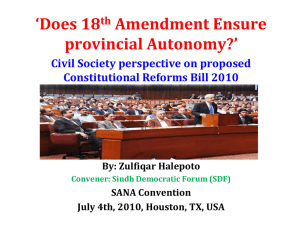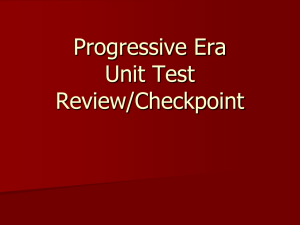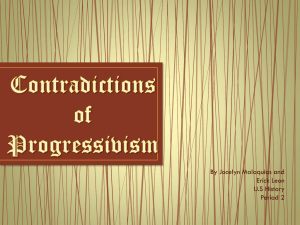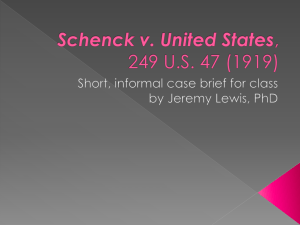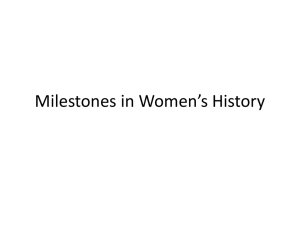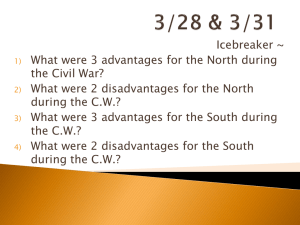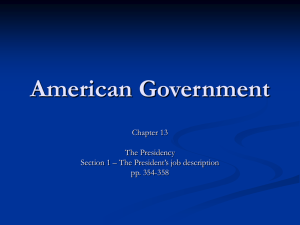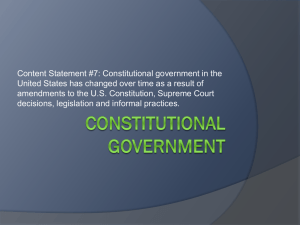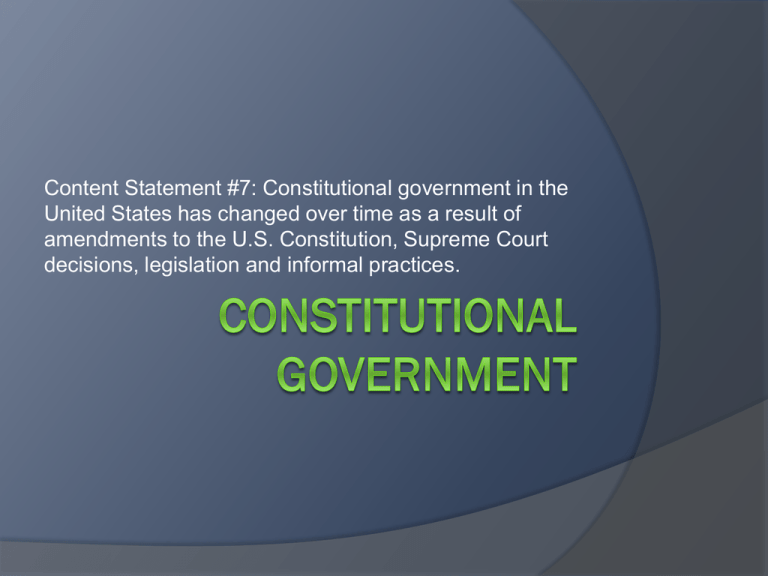
Content Statement #7: Constitutional government in the
United States has changed over time as a result of
amendments to the U.S. Constitution, Supreme Court
decisions, legislation and informal practices.
When Changes Need to be Made
The operations of the
government in the U.S.
take place within a
framework provided by the
U.S. Constitution
The U.S. Constitution has
been amended,
interpreted, supplemented
and implemented in a
variety of ways
Content Statement #8: The Bill of Rights was drafted in
response to the national debate over the ratification of
the Constitution of the United States.
Bill of Rights History
Key argument during the course of the debate
over the ratification of the U.S. Constitution
concerned the need for a bill of rights
Federalists pointed to protections included in the
original document but Anti-Federalists argued that
those protections were inadequate
To secure sufficient votes in the state ratifying
conventions, Federalists pledged to offer a bill of
rights once the new government was established
Massachusetts & Virginia, in accord with AntiFederalist sentiments, went so far as to propose
amendments to the Constitution
including amendments to protect the rights of citizens
Bill of Rights
First ten amendments-ratified
in 1791
Addressed protections for
individual rights (Amendments
1 – 9)
These amendments reflect the
principle of limited government
10th Amendment also
addressed the principle of
limited government as well as
federalism
1st Amendment
Free Speech
Freedom of Religion
establishment or
exercise
Assembly
Press
Petition against the
government
2nd Amendment
A well regulated Militia, being necessary
to the security of a free State, the right
of the people to keep and bear Arms,
shall not be infringed
3rd Amendment
No Soldier shall, in time of
peace be quartered in any
house, without the
consent of the Owner, nor
in time of war, but in a
manner to be prescribed
by law.
4th Amendment
No unreasonable search and seizure
Requirement of a warrant for searches
5th Amendment
No person shall be held to answer for a
capital, or otherwise infamous crime,
unless on a presentment or indictment of
a GRAND JURY
Nor shall any person be subject for the
same offence to be twice put in jeopardy
(DOUBLE JEOPARDY)of life or limb
Nor shall be compelled in any criminal
case to be a witness against himself
(SELF INCRIMINATION)
Nor be deprived of life, liberty, or
property, without DUE PROCESS of law
Nor shall private property be taken for
public use, without JUST
COMPENSATION
Eminent Domain
6th Amendment
Criminal Cases
The accused shall
enjoy the right to a
speedy and public trial
By an impartial jury
Accusation to be
confronted with the
witnesses against him
To have the Assistance
of Counsel for his
defense
7th Amendment
Civil Cases
The right of
trial by jury
shall be
preserved
8th Amendment
Excessive bail shall not be required, nor
excessive fines imposed, nor cruel and
unusual punishments inflicted
9th Amendment
The enumeration in the Constitution, of
certain rights, shall not be construed to
deny or disparage others retained by the
people
10th Amendment
Reserved Powers
to the States
Content Statement #9: The Reconstruction Era
prompted Amendments 13 through 15 to address the
aftermath of slavery and the Civil War.
History of the Reconstruction
Amendments
The conflict over slavery was a
primary cause of the American Civil
War
As the war came to a close, plans to
“reconstruct” the rebellious states
were instituted
The 13th Amendment, which
abolished slavery, was not part of
President Lincoln’s original plan to
readmit former Confederate states to
Congress
Ratification of the 13th Amendment
became a requirement under
President Johnson’s Reconstruction
plan
Amendment 13 (1865)
Slavery is abolished in the United States
Amendment 14 (1868)
Everyone born or naturalized in U.S. are
entitled to rights-EQUAL PROTECTION
UNDER THE LAW
Defined what persons were citizens of the
United States & offered protection from state
infringements on citizens’ rights
Revised the means for determining
representation in the House of
Representatives & included punishments for
former Confederates and their states
No one shall run for office if they are convicted of
treason or uprising
All debts are valid EXCEPT those incurred to fund
insurrection or losses related to slavery
Amendment 15 (1870)
Extended the right
to vote to citizens
regardless of race,
color or previous
condition of
servitude
Content Statement #10: Amendments 16 through 19
responded to calls for reform during the Progressive
Era.
Progressive Era History
Time of political, economic, and
social reform in response to
problems which emerged
throughout the United States in the
late 1800s
Progressive reforms began at the
local level and gradually spread to
the national level, including four
constitutional amendments
addressed issues related to taxation,
representation in Congress, alcohol
use and suffrage
Amendment 16 (1913)
Congress has the power to
tax income
Background:
Concerns over the usage of
tariffs by the federal government
and distribution of wealth in the
country had been raised by the
Populist Party
Progressives took up the call for
reform and the 16th Amendment
was passed to allow for a federal
income tax
Amendment 17 (1913)
Senators elected by popular vote
If Senate seat is vacated, a replacement
Senator is appointed until an election is
held
Cartoon portraying the time it took to pass the Seventeenth
Background:
Amendment allowing the direct election of U.S. senators
Critics of state politics
viewed political party
bosses and business
leaders as having too much
influence on state
legislatures and their
selection of senators
Amendment 17 provides for
the direct election of
senators by the people
Amendment 18 (1919)
Manufacture, transportation, and
sale of intoxicating liquors becomes
illegal one year after ratification of
the amendment
Importation and exportation of
substances also illegal
Background:
Proponents of prohibition had for
decades linked alcohol use to
problems such as poverty & the
destruction of family life
Efforts to ban the use of alcoholic
beverages led to passage of the 18th
Amendment.
Amendment 19 (1920)
Sex cannot exclude a person from
voting
Background:
Longstanding reform effort was
focused on obtaining the right to
vote for women
Women's suffrage in the U.S. was
achieved gradually, at state and
local levels during the late 19th
century and early 20th century,
culminating in 1920 with the
passage of the Nineteenth
Amendment
Content Statement #11: Four amendments have
provided for extensions of suffrage to disenfranchised
groups.
Extension of Voting Rights
A recurring theme in
amending the Constitution
of the United States has
been the extension of voting
rights to more citizens
Over time, the fundamental
democratic practice of
voting has been made
possible for different groups
of people
What Amendments Have We
Already Covered that Would Fit in
this Category?
Amendment 15 prohibits the denial of suffrage
to people because of race, color or previous
condition of servitude
Amendment 19 prohibits the denial of suffrage
on account of sex
Amendment 24 (1964)
The right to vote will not be impeded
upon by any poll tax
Background:
Poll taxes disenfranchised the poor and
were also used as Jim Crow legislation to
deny the right to vote to African Americans
Amendment 24 prohibits the use of poll
taxes in federal elections
Amendment 26 (1971)
Right to vote is extended to citizens 18
years of age or older
Background:
Direct result of many young men being
drafted to fight in the Vietnam War, but not
being able to vote
Content Statement #12: Five amendments have altered
provisions for presidential election, terms, and
succession to address changing historical
circumstances.
Changes to the Executive Branch
Constitutional provisions related to the executive
branch of the federal government have been frequent
subjects for amendment
The amendments have responded to events impacting
presidential elections, terms and succession
Amendment 12 (1804)
Vice President is chosen as a separate office
Defines how electoral college shall vote for Vice
President
Background:
Amendment 12 altered the procedures of the Electoral
College
○ altered the U.S. Electoral College to allow electors to vote
for both a President and a Vice-President in a presidential
election, instead of voting for two different presidential
candidates, or the same presidential candidate twice
The change allowed separate balloting for president
and vice president to avoid a tie in electoral votes
○ as happened in the election of 1800 (Jefferson vs. Burr)
Amendment 20 (1933)
January 20 ends President and Vice
President term
January 3 ends congressional term
Background:
Shortened the time between elections and when
presidents and members of Congress take office
These changes reflected the improvements in
transportation which allowed for easier travel to
Washington
Also reflected the desire to avoid “lame duck”
periods in the transition from one administration
or session to another
Amendment 22 (1951)
No President shall be
elected for more than two
terms, congruent or not
Background:
Imposed a two-term limit on
presidential terms
Passed following the fourterm presidency of Franklin
Roosevelt to institutionalize
the two-term tradition
established by George
Washington
FDR: President from 1933-1945
Amendment 23 (1961)
Electors appointed to District of Columbia
Background:
The Electoral College was originally based
upon electors representing states
Population of the District of Columbia grew
○ it was decided that the residents there
deserved to have the opportunity to vote for
electors in presidential elections
Amendment 25 (1967)
Succession of Presidency
Vice President fills office of President
If Vice President is vacated, New Vice President is appointed
after approval of Senate
Background:
Presidential succession and disability were addressed
Lyndon B. Johnson (who had a history of heart problems)
took office following the assassination of JFK
This left the office of vice president vacant
25th Amendment clarified that a successor to the presidency
was designated as President of the United States and
included provisions for filling the office of Vice President
It also outlined procedures to be used in case of presidential
disability
Content Statement #13: Amendments 11, 21 and 27
have addressed unique historical circumstances.
Unique Circumstances
Three amendments to the United States
Constitution have come about due to
particularly unique circumstances
One amendment addresses judicial power
Another repeals a previous amendment
The most recent amendment took more than
200 years to be ratified.
Amendment 21 (1933)
REPEALS 18th Amendment
14 years later
Background
Congress enacted the Volstead Act to
implement the provisions of the 18th
Amendment
Difficulties in enforcing the law led to
widespread disregard for Prohibition and
increased criminal activities during the 1920’s
A successful 1932 Democratic Party campaign
against Prohibition led to the proposal and
ratification of the 21st Amendment
Amendment 27 (1992)
Congressional pay raises take effect after
the next congressional election
Background:
Originally proposed in 1789 to limit conflicts of
interest among members of Congress in
determining their own compensation
Was not ratified with the 10 amendments known
today as the Bill of Rights
Popular opposition to congressional pay raises
in the 1980’s renewed interest in the
amendment


